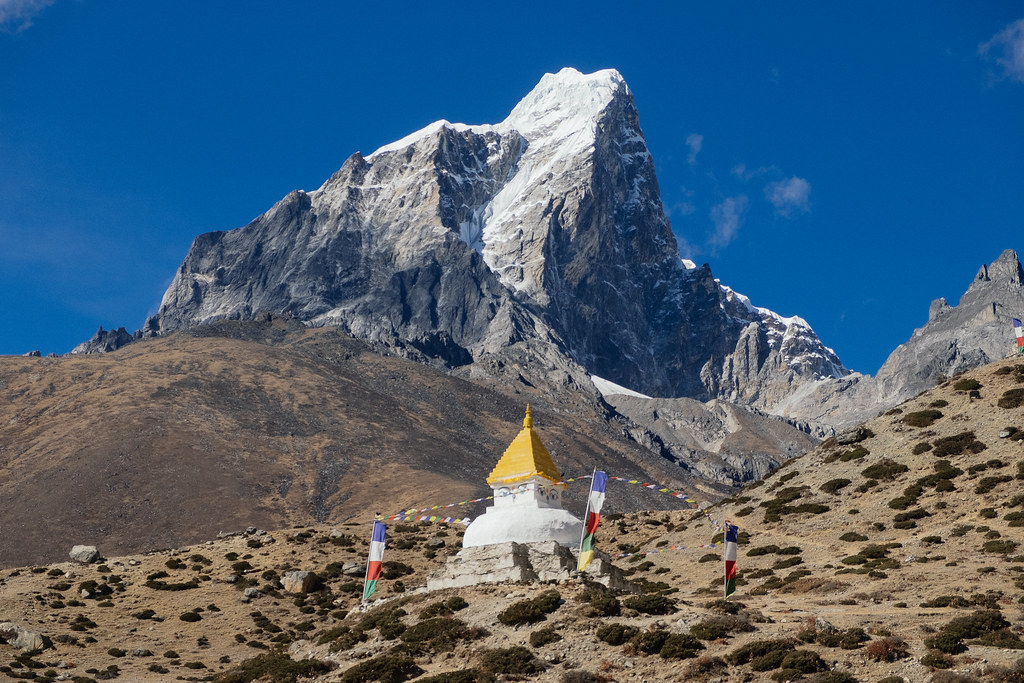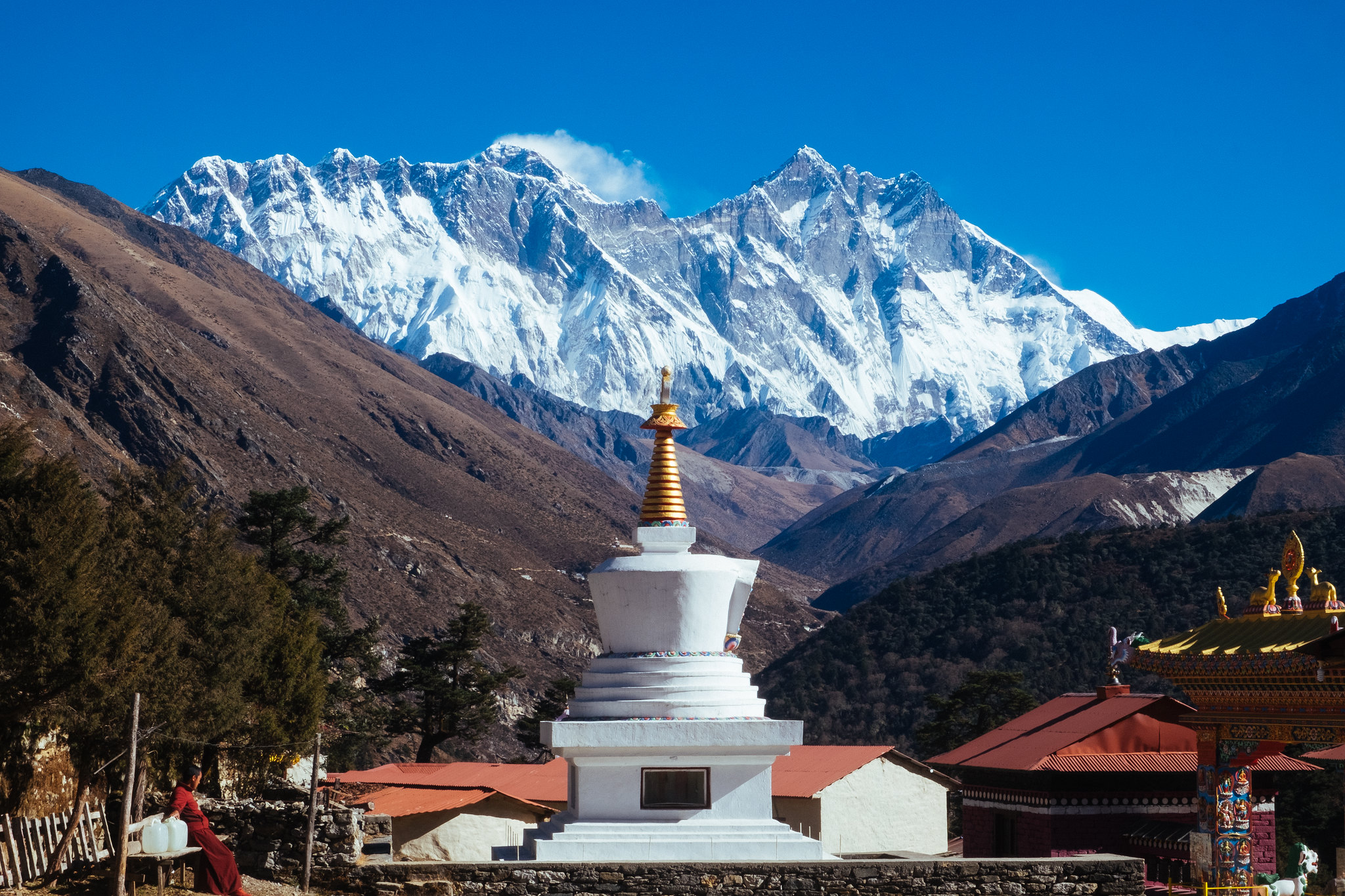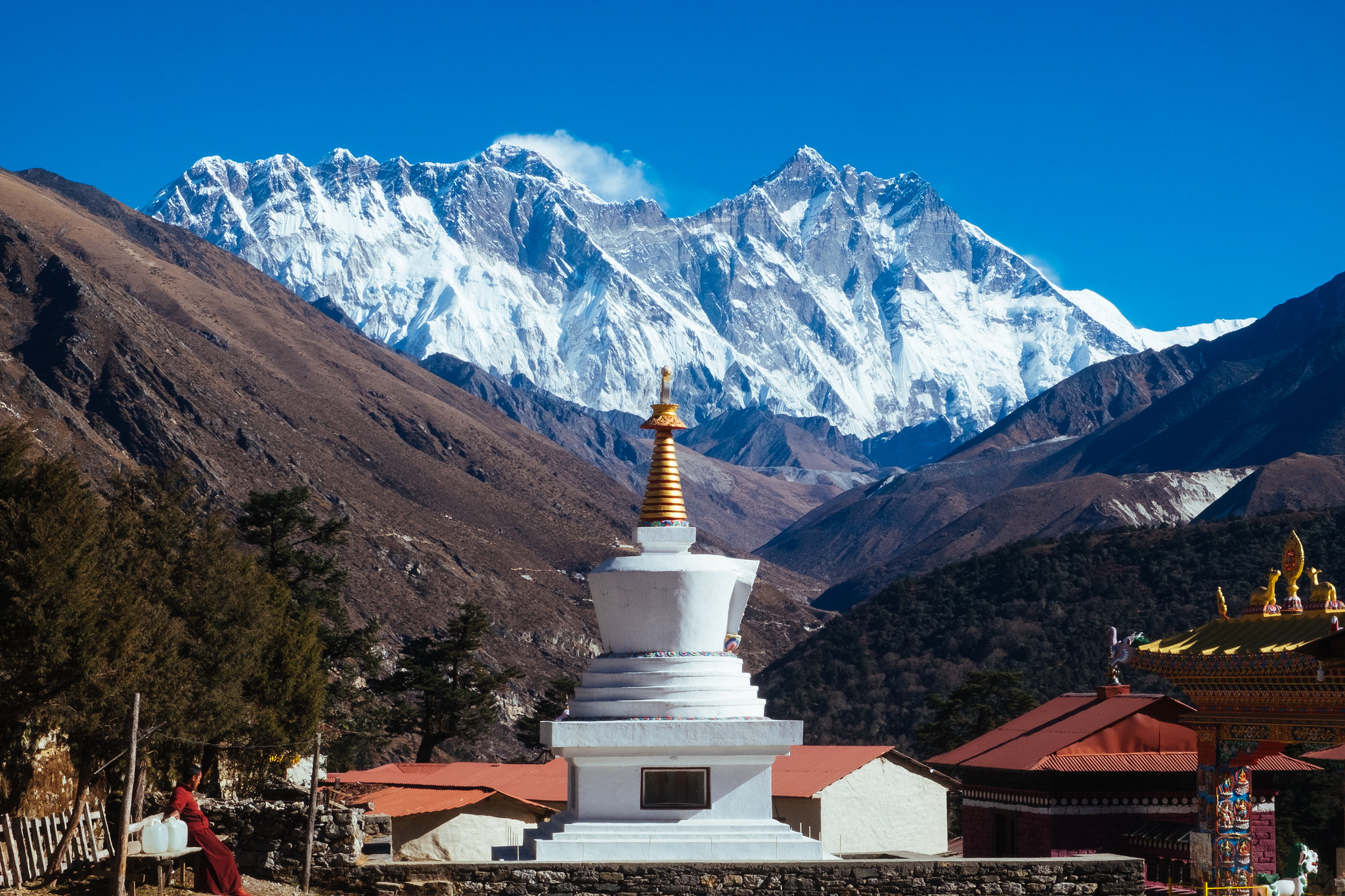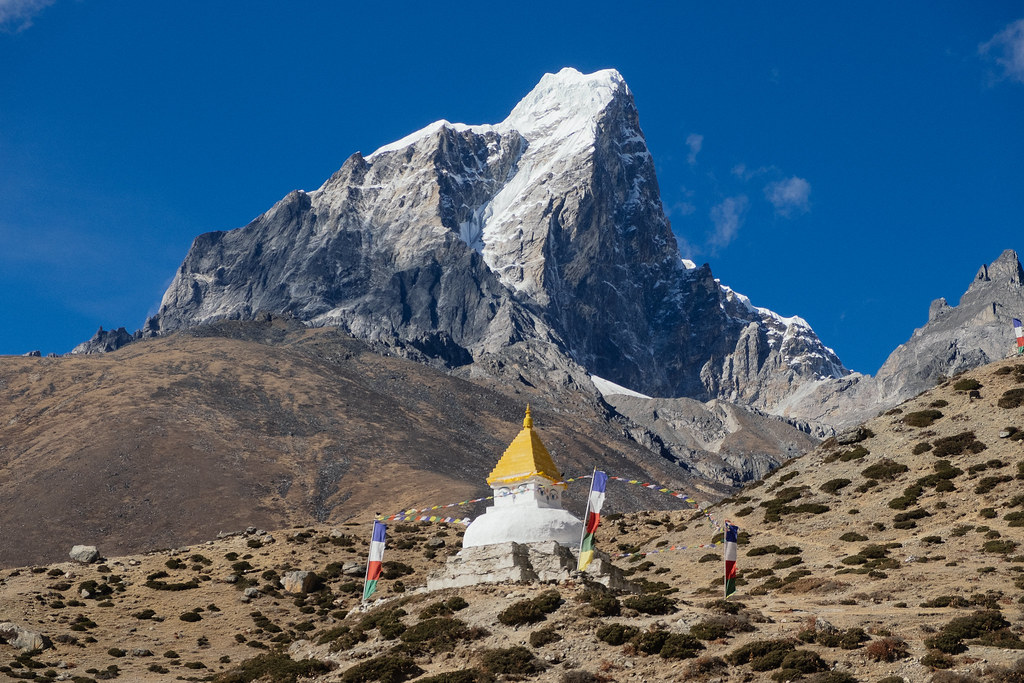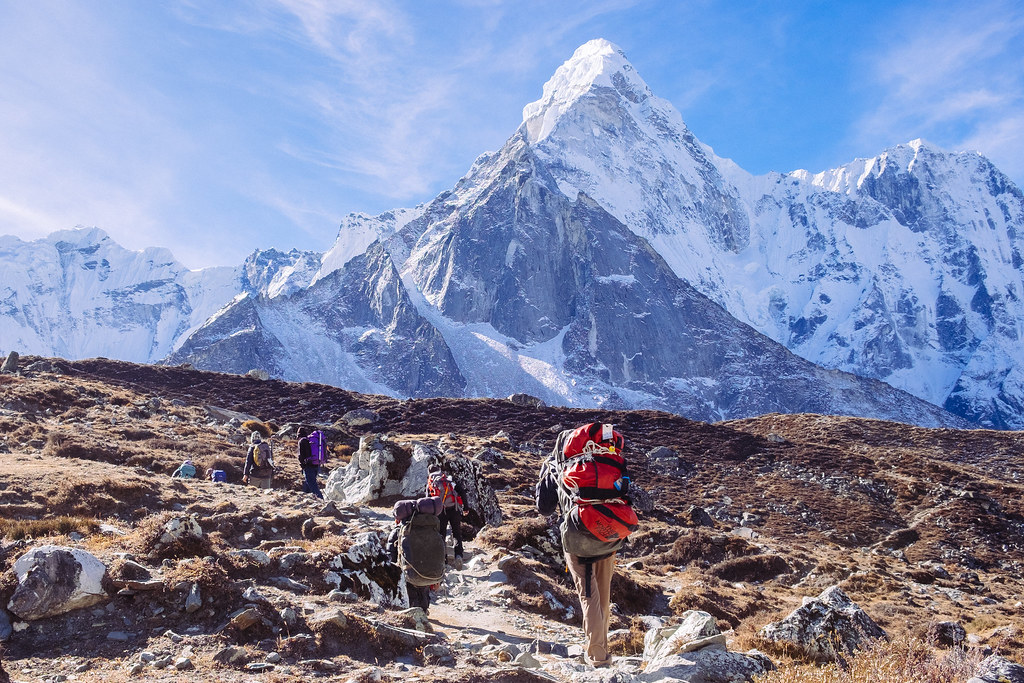Overview
Nepal is a landlocked country located in South Asia with China in the north and India in the south, east and west. The country can be divided into three main geographical regions: Himalayan region, mid hill region and the Tarai region. The highest point in the country is Mt. Everest (8,848 m)
Inclusions
- Economy class air ticket by Fly Dubai
- Airport pick-up & drop-off transportation by private vehicle
- Twin /Double sharing deluxe accommodation in 4-star hotel with breakfast
- Sightseeing in Kathmandu. Escorted with English speaking guide
- Kathmandu / Lukla / Kathmandu flight
- Accommodation in normal tea house with attached bath where available
- 3 Meals - during trek
- A First Aid and Eco trained & government licensed English speaking guide
- Accommodation, meals, salary, equipment, transportation & Insurance of trekking staff
- First Aid kits
Exclusions
- Visa Fee
- Medical evacuation in case of emergency
- Personal gear & clothing - these may be available for hire
- Tips, any expenses of personal nature, client's insurance
- Expenses incurred due to mishaps, landslide, strikes, political unrest etc
- Anything not specified in the Cost Include section
-
1
Arrival in Kathmandu
Welcome to Kathmandu, the capital of Nepal. The Langtang Ri Trekking & Expedition representative will greet you at the airport and transfer you to your hotel. After your refreshment you will be picked up from your hotel lobby and driven to our Thamel office where you will be formally introduced to your trekking guide. We will go through all your trek itinerary and arrangements with you to insurer every detail is in place. We will also ask to bring your passport, extra passport photographs and a copy of your travel insurance so that we can organize permits required for your trek in the Sagarmatha National Park.
-
2
Sightseeing in Kathmandu
After breakfast, we start an interesting tour around Kathmandu. Escorting by an English-speaking guide (can provide any language speaking guide on request) the tour will give you a taste of our vivid Nepali culture and history. On our sightseeing tour, we go to Monkey Temple Swayambhunath, Pashupatinath, Bouddhanath, and Kathmandu Durbar Square. Bouddhanath: Bouddhanath is a Buddhist religious complex with a history dating back over 500 years. Located on the eastern edge of Kathmandu it is now a site of great pilgrimage for Buddhist followers who circle its massive stupa, spin its many prayer wheels and visit its beautiful monastery. The main feature of Boudhanath is its huge hemispherical white stupa with a central golden tower and the all-seeing eyes of the Buddha. Visitors should circle the stupa in a clockwise direction and spin prayer wheels for good fortune and a good life. Visitors may also enjoy visiting the thangka painting school within the complex to see highly skilled artists at work on religious mandala paintings. Pashupatinath: This Hindu Temple is a very large complex and focal point for the Hindu religion in Nepal. This old and very revered complex of buildings and shrines is dedicated to Lord Shiva, one of the main deities of Hinduism. While Lord Shiva has multiple forms, he is often seen as the destroyer. This has great significance for the Pashupatinath temple as it is the site of many Hindi ritual cremations each day. Pashupatinath is considered by Hindus to be an auspicious site for passing from one stage of life to the next through the purifying and destroying flames of cremation. However, on a happier note, visitors may also get to see the temple in a buoyant festival mode with one of the many Hindu festivals celebrated here throughout the year. Swayambhunath: You will first visit the Swayambhunath temple complex that sits atop a high hill overlooking Kathmandu and the entire Kathmandu Valley. Swayambhunath is perhaps the most sacred Buddhist pilgrimage site in Nepal. It consists of a very large white stupa with the all-seeing-eye of Lord Buddha plus many small stupas and beautifully carved stone shrines. This is a wonderful place to catch your breath and start to understand and appreciate the deep importance of Buddhist belief to the people of Nepal and the Himalaya region. Make sure you ring the many bells to awaken the gods and let them know you are in Nepal. Take the time to enjoy the view over Kathmandu and have your guide point out the many other highlights of the city. In the far distance to the east, you may also be able to see the hills of Nagarkot. If you feel energetic you might also like to try some or all of the 350 steps that lead all the way from Kathmandu city up to your Swayambhunath temple vantage point. Kathmandu Durbar Square: The next stop today is the beautiful Kathmandu Durbar Square or the royal palace square of the ancient Malla Kings of the Kathmandu Valley. This square and all its architectural treasures are a UNESCO World Heritage Site. While some damage to buildings occurred in the 2015 earthquake the site still contains many stunning architectural gems. The original royal palace courtyards are open to visitors and you will marvel at the intricate timber carving and beautifully crafted brickwork of the palace. The open square outside the palace has many beautiful multi-story pagodas and temples with ornate carving and carpentry artwork that tells some of the stories of the ancient kings and their mystical time and beliefs. The square also contains many important Hindu temples and statues such as Vishnu and Lord Shiva. Durbar Square also contains the unique and intriguing Kumari Chok. This is an ancient and ornate house where resides the Raj Kumari – the Living Goddess. She is a young girl chosen through an ancient and mystical selection process to become the human incarnation of the Hindu mother goddess, Durga. If you are in the courtyard of her home at the right time in the afternoon you may see a brief glimpse of the Goddess at her window.
-
3
Flight Kathmandu to Lukla and commence Trek to Phakding (2610m/3hrs)
Very scenic flight to Lukla, just south of the entrance to the Sagarmatha National Park and the Mount Everest region. The flight is brief and takes only about thirty minutes. Once in Lukla and all your packs and equipment are organized you will start your trek with the walk northwards along the Dudh Kosi River valley to the village of Phakding and its impressive suspension bridge over the river far below. At this stage, the scenery is a well vegetated and impressively large river valley with glimpses to the north of the towering snow-capped Himalayan peaks that await you.
-
4
Trek from Phakding up to Namche Bazaar (3440m/6 hrs)
The first stage of the walk takes you across the river and to the village of Monjo and the actual entrance to the Sagarmatha National Park. Your guide will handle all the formalities of ensuring you are carrying the necessary permit to enter the national park. All necessary permits will have been arranged for you following your visit to our head office a day or two earlier. The second stage takes you upwards from 3,440m altitude Namche Bazaar - so a very substantial altitude gain of over 1,600m is achieved in this stage - so just take it slow and steady up the many steps to Namche Bazaar and enjoy the scenery and beautiful mountain summit vistas deeper in the national park.
-
5
Acclimatization in and around Namche Bazaar(3440m)
Since you will now be at quite a significant altitude you must let your physiology adapt the thinner atmosphere and reduced oxygen levels. This is an essential step in the proper management of the risk of altitude sickness. Your guide will personally instruct you on what to do during the day and how best to acclimatize and how to identify any early symptoms of altitude sickness. There is plenty to see and do in Namche Bazaar itself and in the immediate surrounding area. So, taking a rest day can be an interesting and fun day too. Talk with your guide about visiting places such as the famous Edmond Hillary School established to assist the Sherpa community and residents of the region. Or perhaps pay a visit to the beautiful Everest View Hotel - the view of the Mount Everest summit can be inspiring for the next days of your trek.
-
6
Namche Bazaar to Tengboche (3867m/5-6hrs)
Today you will head a little higher and closer to Everest Base Camp. Your walk will take you via one of the many scenic trails to the very important village of Tengboche and its world famous Tengboche Monastery. Take your time and enjoy the gorgeous mountains along the trail. Look for the very distinctive twin-peak summits of Mount Ama Dablam and the towering snow and ice-capped mass of Mount Thamserku. This walk takes about five hours to complete and the last section brings you up to the distinctive gates of Tengboche village. Take the time to visit the monastery. Your guide will explain some of the history of the facility, its significance to the Sherpa community and its importance to Buddhism. Then get some rest for the next stages of your trek.
-
7
Trek from Tengboche to Dingboche(4260m/6hrs)
Today you cross the altitude transition from trees and shrubs lining the trek path to bare ground above the tree line. This is the point where the long hard winter and extended deep winter snow cover make it impossible for trees to establish and grow. Today you can clearly see that you have gained some substantial altitude since the commencement of your trek at Lukla. You start your five hours walk through grazing lands and beautiful rhododendron forests as you head towards the little village of Pengboche. Take a short break in Pengboche and visits its Buddhist gompa, a place of study and contemplation for monks learning the ways of Buddhism. Then continue on to Dingboche and soak up the stunning Himalayan vista that surrounds you.
-
8
Acclimatization at Dingboche(4260m)
The altitude at Dingboche means there is just 61% of the oxygen available to sea level. So, as you gain altitude your lungs and heart have had to work much harder to supply the oxygen your body requires for walking and even just sitting and resting. Your body is also adjusting in less obvious ways to make your blood more efficient at capturing and transporting oxygen. Your body is also adjusting to the different way it stores and moves fluid at high altitude. Your Sherpa guide and porters have the natural physiology to handle the effects of altitude, however, you must give your body time to adjust before you can more safely proceed higher to Everest Base Camp and any of the even higher vantage points that offer spectacular mountain views. So, listen to your guide and that the advice to rest and acclimatize properly today
-
9
Trek from Dingboche to Lobuche(4930m/6hrs)
Another five hour walk today that takes you to an altitude of almost five kilometers - many aircraft do not even fly this high! You will pass little settlements were a short break and cup of tea will fuel you for next stage. As you reach Lobuche you will be walking the southern section of the mighty Khumbu Valley and be walking beside the shattered and creaking ice and moraine of the Khumbu Glacier that drains from the flanks of Mount Everest itself. This is a high Himalayan landscape that can leave some trekkers thinking they are exploring another planet. Today's walk will also take you past the tiny settlement of Periche that is home to the Himalayan Rescue Association Aid Post. This wonderful facility is staffed by international volunteer doctors and can provide excellent care to trekkers or expedition members suffering signs of altitude sickness.
-
10
Trek from Lobuche to Gorakshep settlement and on to Mount Everest Base Camp(5160m/8hrs)
Your trail will take you along the western edge of the Khumbu Glacier initially to the small settlement of Gorakshep. This is a very well-appointed location with accommodation and all the facilities a trekker may need. A quick tea stop might be useful before pushing on to the goal of this trek - Mount Everest Base Camp. The walk continues northward along the edge of the glacier before arriving at the shattered jumble of ice and snow that is the main camp site for expedition parties attempting to summit Mount Everest. However, it depends on the month you visit as to whether expedition parties will be encamped. There are short seasonal windows before and after the annual monsoon when the ascent of Mount Everest is potentially possible. But once you arrive at base camp the presence or absence of expeditions is immaterial - just take in the awe of Mount Everest, the Khumbu Icefall and the many 7,000m plus peaks jutting towards the sky in every direction you look. This is the power of nature at its most impressive. You will complete the day be returning to your accommodation for the night at Gorakshep.
-
11
From Gorakshep walk up to the Kala Pattar(5545m) vantage point and then descend to Pheriche (4,243m/6hrs)
Sunrise from the top of Kala Pattar is just a spectacular sight you will always remember and no doubt record in many photos. But the walk up to the vantage point at 5,545m altitude is steep and a challenge, often requiring a slow two-hour walk. At the top, 5,545m, you have just 52% of sea level oxygen available to you, so some exertion is required. But the rewards for this effort are beyond words - all of the most beautiful and inspiring Himalayan peaks and rugged icy landscapes are laid out before you as you are left speechless by the power and beauty of the west face of Mount Everest, its neighboring peaks of Nuptse and Lhotse and the nearby summits of Ama Dablam, Thamserku and more peaks than you can count. Kala Pattar is the Himalayan vista high point, literally, of any Everest Base Camp trek.
-
12
Descend from Periche to Tengboche (3867m/5hrs)
You will find you walk a little easier and faster with each hour as you descend and gain a little more oxygen with each breath. But take your time, continue to enjoy the mountain scenery and perhaps pay a visit to the Nagkartshang Gompa on the way to Tengboche.
-
13
Descend from Tengboche to Namche Bazaar(3440m/5hrs)
You head through familiar trails and scenes as you proceed largely downhill for four or five hours of easy walking. There are still a few hills to summit but you will find it easy going today. You will also pass through Khumjung and Khunde where you may like to take a break and visit its little monastery. Visitors are always welcome.
-
14
Return from Namche Bazaar to Lukla(2886m/8hrs)
Today involves a four hour walk as you descend rapidly from Namche Bazaar and head for Phakding. Depending on your group and the weather conditions you may spend the night in Phakding or continue on to Lukla. Since this evening will be the last on your trek it will be time for some celebrations with your guide and fellow trekkers. A few drinks, some music and some Sherpa and Nepali dancing is often on the menu. So please celebrate your achievements and friendships of this trekking experience
-
15
Flight from Lukla to Kathmandu (1,300m)
Your flight from Lukla will depart early in the morning and from the airport, we will soon have you back in your Kathmandu hotel.
-
16
Kathmandu free day to explore and shop (1,300m)
Enjoy a day exploring some of the quieter streets of Kathmandu and stocking up on souvenirs and presents for friends and family. This evening you will also have a farewell dinner. We will collect you from your hotel and take you to one of the many bustling and fun restaurants of Kathmandu.
-
17
Departure for Home (1,300m)
Drop off at the Airport
- Prices are subject to change
- Flights & hotel accommodation is subject to availability
- Conditions Apply



